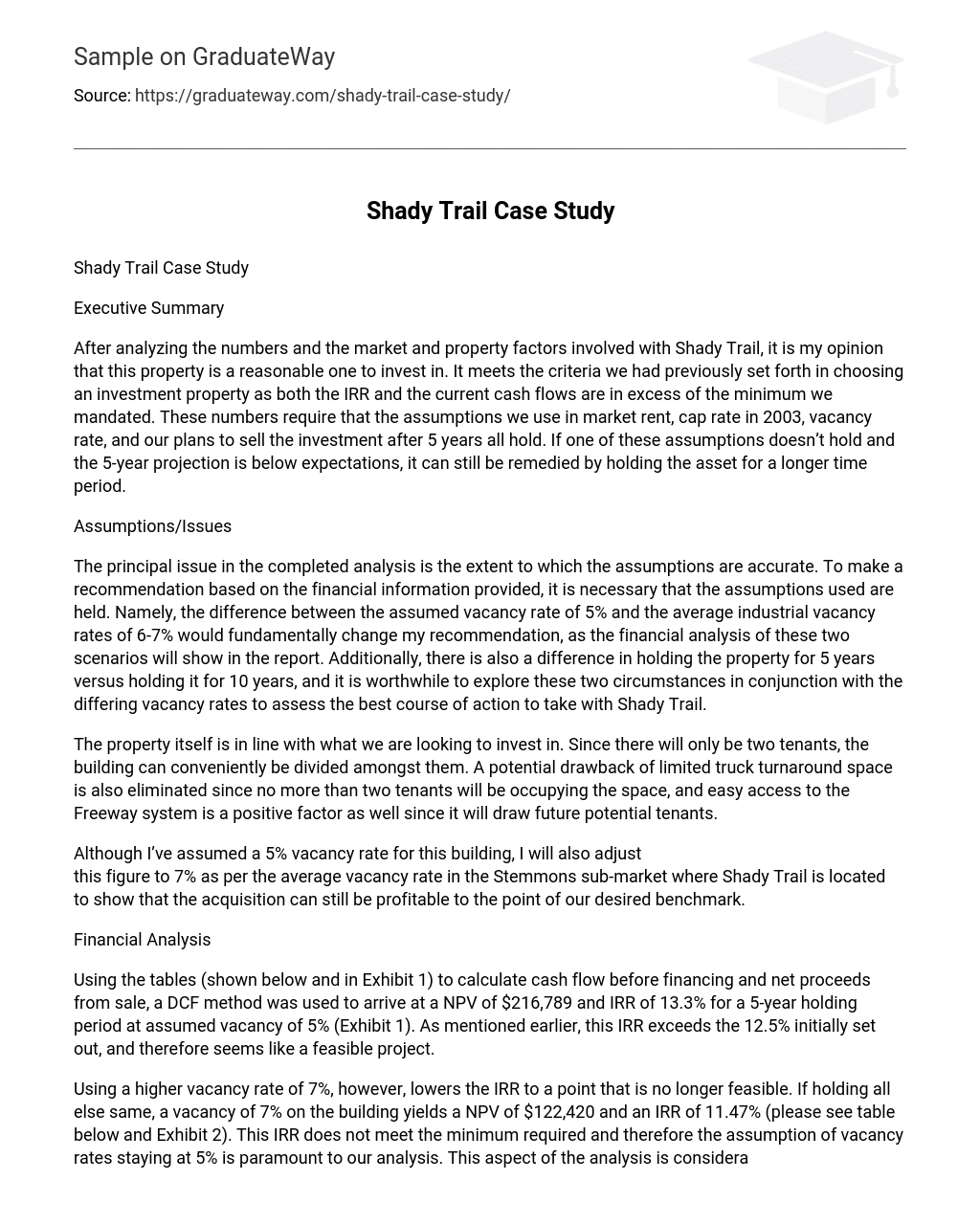Executive Summary
After analyzing the numbers and the market and property factors involved with Shady Trail, it is my opinion that this property is a reasonable one to invest in. It meets the criteria we had previously set forth in choosing an investment property as both the IRR and the current cash flows are in excess of the minimum we mandated. These numbers require that the assumptions we use in market rent, cap rate in 2003, vacancy rate, and our plans to sell the investment after 5 years all hold. If one of these assumptions doesn’t hold and the 5-year projection is below expectations, it can still be remedied by holding the asset for a longer time period.
Assumptions/Issues
The principal issue in the completed analysis is the extent to which the assumptions are accurate. To make a recommendation based on the financial information provided, it is necessary that the assumptions used are held. Namely, the difference between the assumed vacancy rate of 5% and the average industrial vacancy rates of 6-7% would fundamentally change my recommendation, as the financial analysis of these two scenarios will show in the report. Additionally, there is also a difference in holding the property for 5 years versus holding it for 10 years, and it is worthwhile to explore these two circumstances in conjunction with the differing vacancy rates to assess the best course of action to take with Shady Trail.
The property itself is in line with what we are looking to invest in. Since there will only be two tenants, the building can conveniently be divided amongst them. A potential drawback of limited truck turnaround space is also eliminated since no more than two tenants will be occupying the space, and easy access to the Freeway system is a positive factor as well since it will draw future potential tenants.
Although I’ve assumed a 5% vacancy rate for this building, I will also adjust
this figure to 7% as per the average vacancy rate in the Stemmons sub-market where Shady Trail is located to show that the acquisition can still be profitable to the point of our desired benchmark.
Financial Analysis
Using the tables (shown below and in Exhibit 1) to calculate cash flow before financing and net proceeds from sale, a DCF method was used to arrive at a NPV of $216,789 and IRR of 13.3% for a 5-year holding period at assumed vacancy of 5% (Exhibit 1). As mentioned earlier, this IRR exceeds the 12.5% initially set out, and therefore seems like a feasible project.
Using a higher vacancy rate of 7%, however, lowers the IRR to a point that is no longer feasible. If holding all else same, a vacancy of 7% on the building yields a NPV of $122,420 and an IRR of 11.47% (please see table below and Exhibit 2). This IRR does not meet the minimum required and therefore the assumption of vacancy rates staying at 5% is paramount to our analysis. This aspect of the analysis is considerably risky as an assumed vacancy rate does not necessarily yield a guaranteed rate. If vacancy happens to rise, then the valuation of the property is far different than what was originally envisioned. + MAX PRICE +after-tax current CF
Recommendation
Since various assumed parameters used cannot be guaranteed, my recommendation to hedge against potential changes in the valuation model is to acquire the property and hold it over 10 years instead of 5. That way, we would be utilizing the positive leverage of the mortgage on the property for a longer timeframe, and additionally take advantage of the increased rent starting in year 6 at $3.77/ sq ft. Exhibit 3 shows the IRR for a 10-year holding period. Even though the higher assumed vacancy rate of 7% is used, the IRR is still 13.75% with a NPV of $462,191. + MAX PRICE
When comparing this with the IRR obtained on a 5-year timeframe with 5% vacancy, it is evident that risk is partly mitigated as the additional 5
years provides higher cash flows and the sale price in year 10 is considerably higher than what we would get by selling in year 5.
Additionally, with the assumption that rents will increase in year 6, the leverage of the loan throughout the 10 years of the property is positive. A downturn in the market is not expected, and therefore it is my opinion that the loan being offered by Lonestar is quite attractive and should be taken advantage of. It is highly beneficial that direct financing is being provided for the deal at a time when financing is tightening up as it saves us considerable time and resources. Moreover, it is important to be able to renew the leases at the building with the current tenants. By doing so, we would prevent having to pay an additional $120,000 in tenant improvement costs and 15% of the first year’s net rent in leasing commissions, which would otherwise negatively affect the current stated IRRs.
The analysis of a 5-year holding period at the lower vacancy rate would be sufficient for me to recommend moving ahead with this property. However, since we run the risk of potentially changing assumptions, it is my recommendation to forge ahead with the purchase with the expectation that the property will be held for 10 years so as to increase the IRR and mitigate the risks involved.





